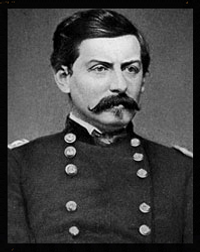United States History
By: Elena Cantwell
The Battle of Antietam
Date & Location
17 September 1862
Faught near Sharpsburg, Maryland and Antietam Creek
Known as the Battle of Antietam and the Battle of Sharpsburg
("Civil War")
Confederate Commander and Objective
Known for being one of the bloodiest Civil War battles, the confederate army lost 1,546 men, 7,754 men wounded, and 1,018 men wounded. Under the command of General Robert E. Lee, the Confederate army was on its way from northern Virginia to Maryland ("Antietam"). Lee hoped to gain the support of the Marylanders, Maryland being an important border state, to boost the strength of the Confederacy. Another strategy by coming to Maryland was to lure Union troops out of Virginia to temporarily relieve the area of war and also to make advances on the Union Capital, Washington D.C. The Union officers caught wind of Lee's plans and met him in Sharpsburg, Maryland where the Union launched an uncoordinated attack on Lee's Confederate Army ("Battle of Antietam")

General Robert E. Lee
Union Commander
General George B. McClellan found out that General Lee was planning to go towards Maryland and carefully moved the Union army into positon to catch the Confederates on their way into Maryland (Brinkley, 361). The Union army had a higher death toll than the Confederacy, losing 2,108 men, and 9,549 men were injured ("Antietam"). If McClellan had been more assertive in this battle, he might have broken through Lee's army, but instead he allowed Lee to retreat to Virginia and squandered the opportunity to defeat the Confederates. McClellan was then fired from command in November (Brinkley, 361).


en.wikipedia.org
Summary of the Battle
After McClellan learned that Lee was on his way to Maryland after intercepting a copy of Lee's orders, McClellan stalled and gave the Confederates time to make it all the way to Sharpsburg instead of launching a preemptive attack before the army had the chance to make it so far. McClellan's army of 87,000 soldiers finally attacked Lee's 50,000 men force and both armies faced extreme casualties. Eventually Lee's army retreated and the Union lost the chance to crush the Confederacy after this battle (Brinkley, 361). With over 26,000 men dead, wounded, and missing, McClellan thought he was doing the right thing by holding one full army in reserve, however many Union war strategists were angry with his poor, overly-cautious decisions and fired him from his positon (Garrison, 136). Many historians believe that the Battle ended in a draw, but based on the political action taken after the battle, it is officially declared as a Northern victory ("Battle of Antietam").
Outcome
The announcement of Union Victory was almost immediately followed by the Emancipation Proclamation, on September 22, 1862, freeing slaves in all the "rebellious" states ("Battle of Antietam"). This battle opened the doors for the meaning of the war to be changed from the issue over states’ rights to the moral issue over slavery and the Union gained more support ("Civil War"). The victory gave the United States and other countries who were interested in the progress of the war the impression that the North was more successful and on the path to complete victory over the confederacy (Sachs and Spaulding).



(World History in Context)